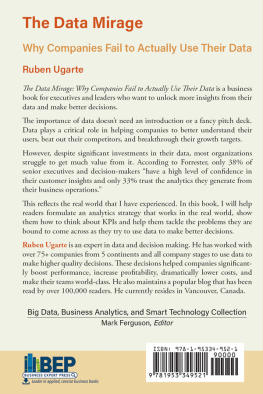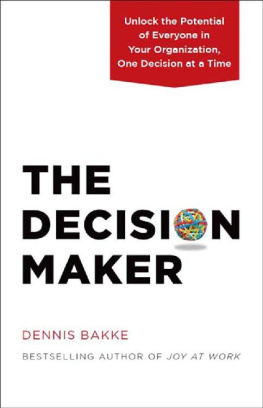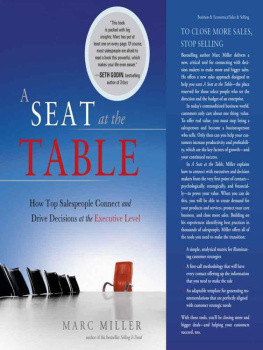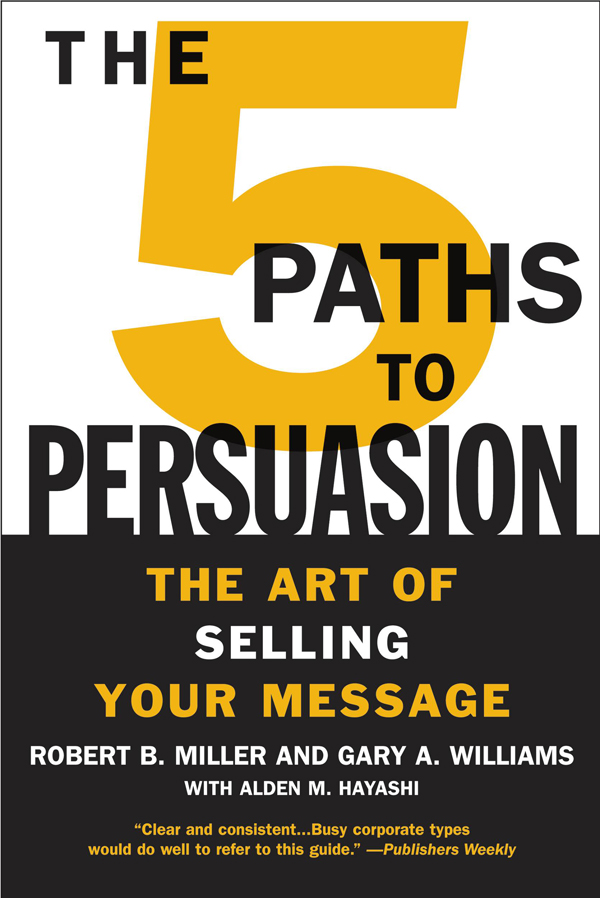Copyright 2004 by Robert B. Miller and Gary A. Williams
All rights reserved.
Warner Business Books / Warner Books
Hachette Book Group USA
237 Park Avenue, New York, NY 10017
Visit our Web site at www.HachetteBookGroupUSA.com.
First eBook Edition: April 2004
ISBN: 978-0-446-50604-5
Strategic Selling
Conceptual Selling
Successful Large Account Management
Throughout The Five Paths to Persuasion, our goal has been to present an open and candid discussion of the five styles of decision makers and the ways to influence each. To accomplish thatwhile also respecting the confidentiality of our many clients and colleagueswe have used pseudonyms for them and their companies, and weve also altered certain identifying details of their experiences. For the examples of prominent CEOs and other executives (Carly Fiorina of Hewlett-Packard, Bill Gates of Microsoft, Larry Ellison of Oracle, and so on), some of our classifications of their decision styles are based on our firsthand observations and dealings with them; other categorizations are based on secondary sources, including an extensive review of media accounts of how theyve made business decisions. Lastly, for the sake of simplicity, we have used the word we loosely throughout this book to indicate both or just one of us.
RBM and GAW
No book just gets written. The origins of this book began many years ago in questions raised by colleagues, friends, family, and clients. Over the years we have been very fortunate to have worked with literally hundreds, if not thousands, of people who not only encouraged us in the development of our ideas and methodologies but also felt strongly enough to coach and critique us. Too numerous to mention individually, we nonetheless acknowledge and are grateful to them all. Three individuals contributions call for special recognition.
Our literary agent, Daniel Greenberg, and his firm, Levine & Greenberg, have proven themselves to be superb advocates for us to the publishing world, and a constant source of excellent coaching and support. Our abundant thanks.
Rick Wolff, our executive editor at Time Warner Business Books, is the best. His enthusiasm for this project has been contagious, and his encouragement along the path has been much appreciated. It is always great to be in the hands of a true professional.
Finally, our colleague and collaborator, Alden Hayashi, has made this project a joyous endeavor. Not only is he a truly gifted writer and wordsmith, his ability to probe and question us in depth about our research and its implications has produced a much better book than we could have completed by ourselves. Our gratitude is great.
ROBERT B. MILLER
GARY A. WILLIAMS
Spring 2003
Ask yourself this question: Is it important to understand how the decisions that affect my companys success will be made? Information and ideas zip around faster than ever before. And while much has been written to help the members of the business community deal with an increasingly complex environment, surprisingly little attention goes toward understanding the fundamental building block of business: individual decision making.
About ten years ago, I had dinner in a small restaurant with Bob Miller. Bob was already a well-established authority on sales and marketing practice with his groundbreaking work represented in the Strategic Selling and Conceptual Selling books and seminars. Our organization was very interested in accelerating its growth, and Bobs guidance did much to help us understand an effective process for setting sales strategy and tactics. During dinner, our conversation turned to the notion of a decoder ring, some way of interpreting the words, actions, and attitudes of decision makers. The value of the decoder ring is that the people representing a company would be more comfortable and effective in building relationships and exchanging information with the decision makers they wished to serve. You see, I had already experienced the unpleasant frustration of having the best solution to a customers problem and still finishing in second place.
Fast-forward to about four years ago. Bob came by my office and introduced his partner, Gary Williams. I quickly came to respect Garys intellect and enthusiasm. With his understanding of research methodology and his uncanny ability to interpret data, and Bobs knowledge of sales process and relationship dynamics, the two make a powerful team. We talked about a couple of projects Bob and Gary proposed tackling for our firm. As our meeting drew to a close, Bob made a reference to our dinner conversation years ago. We have been working on that decoder ring, he said.
Most of us in business spend a lot of time, energy, and money on developing and delivering the right products and services in hopes of filling a customers needs. But all of this effort amounts to nothing if the right decision makers dont feel compelled to buy. With The Five Paths to Persuasion, Bob and Gary articulate a fresh, straightforward viewpoint on understanding executive decision styles. This book will help you to translate your ideas into a more compelling case whether you are influencing an internal or external decision maker. Bob and Gary, thanks for the decoder ring!
JACK DONOVAN, President,
ARAMARK Education Services Group
May 4, 2003
A NEW FRAMEWORK FOR UNDERSTANDING PERSUASION
Introduction
It was a tense weekend. Jason Wheeler and Ed Reynolds, entrepreneurs in Los Angeles, kept on trying to reach their new business partner, Rick Pearson. They called frantically, first Pearsons office, next his home, and then his place in Palm Springs, hoping he might be spending the weekend there. But Pearson was nowhere to be found, and Wheeler and Reynolds had been counting on him for the $100,000 investment he had promised to give them that Friday.
Earlier, Pearson had been ecstatic about the deal. A self-made multimillionaire, he was bored and had been looking for new business opportunities. So when Wheeler and Reynolds told him about this new urban recording artist who had just broken from her recording company, Pearson was instantly enthralled with the idea of signing her up and launching a new label to advance her career. He had promised Wheeler and Reynolds the $100,000 as an initial investmentmoney that the two men were now counting on to finance some promotional work for her. But then Friday rolled around and Pearson had all but disappeared. What happened?
In todays tough business environment, deals are being lost, promotions are being scuttled, and raises are being denied because people lack the necessary skills to effectively persuade others. Even win-win proposals that should have been no-brainers are instead being tabledthe victims of intense scrutiny and skepticism. Indeed, especially in tough times, good ideas do not sell themselves; they need help.
In The Five Paths to Persuasion, we present a new framework for understanding how best to influence others. From our two-year study of nearly seventeen hundred executives, we have found that persuasion is most effective when its tailored to one of five types of people:
Charismatics, like Jack Welch and Oprah Winfrey, who are easily enthralled with new ideas, particularly bold and innovative ones, but will not make a move until they are sure that others have thought through the details
Thinkers, like Bill Gates and Michael Dell, who need to cautiously and methodically work through each pro and con of every conceivable option before rendering a decision









